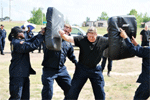
Body guards are a sub-classification of security or watch guards and provide personal protection for a day or more or can be assigned more permanent delegations that can last any number of years. Whether it’s the President of the United States or a child of a celebrity figure, armed body guards play a vital role in a world that is volatile and unpredictable, and they are in high demand. Body guards are not intended to simply fight off attackers, but rather, be a proactive observer and analyzer and neutralize a situation before it ever has a chance to escalate. This is achieved through careful planning and meticulous attention to detail. Being mentally sharp is a pre-requisite.
Body-Guard Training:
Training in this specialized arena is as interesting as it is intense. Typically, instructors are former body guards, former law enforcement personnel or professionals who have served in the military’s Special Forces. Trainees are placed in real-world simulations that accentuate stress and potential dangers that could be, realistically, encountered. Some of the training basics include:
1…evasive driving
2…surveillance techniques
3…environmental awareness
4…weapons usage
5…live ammo training
6…public relations
7…non-lethal weapons training
8…self-defense
9…first aid/CPR
There is, also, advanced body-guard training that offers a deeper, more thorough study of the areas listed.
Bodyguard Duties:
1…Threat Assessment:
Threat assessment involves proactive measures a bodyguard or guards would necessarily perform to pave the way for protected individuals who either desire or are in need of travelling certain routes that could be riddled with potential dangers. Once a safety assessment is made, any pertinent routes are prepared with safety measures to ensure the secure passage of all involved.
2…Escort:
Body-guards are the protected client’s shadow in that the protector never leaves the protected; and assessment is the name of the game. Whether a body-guard and his shielded companion are within a building or on outside premises, the guard has no time, nor desire, to let down his proactive defense. He will continually scan the surroundings to pick up on anyone or any circumstance that look even remotely suspicious. If there is reason to believe an unwanted situation could be brewing, the client will be whisked away for protection. With situations that do not appear as threatening but could still be concerning, a body-guard might stay in constant communication with teammates who may be equally involved in the client’s safety.
It is not uncommon for a body-guard to be the client’s driver, as well. Escorting a client to and from daily activities may be a bit mundane, but being trained in evasive driving techniques can prove to be a lifesaver if a high-speed chase were to develop due to an unexpected and threatening situation involving multiple vehicles.
Some days can be common and ordinary while other days can be out of the ordinary. In 2003, one of Snoop Dog’s bodyguards was injured when the vehicle the rapper was travelling in (as part of a convoy) was sprayed with bullets. Fortunately, the body-guard recovered; and interestingly, Snoop Dog had a total of seven body-guards who accompanied him at the time.
The best defense of a body-guard is not his physical strength, nor his hidden pistol; it’s his intelligence and keen insight and foresight. On any given day, there is a 98% chance nothing will go awry for a bodyguard and his client, but it’s the 2% that an astute body-guard will continually focus on.
Having been an educator for decades, I understand the value of helping individuals make informed, healthy decisions. Karen, Iowa.

